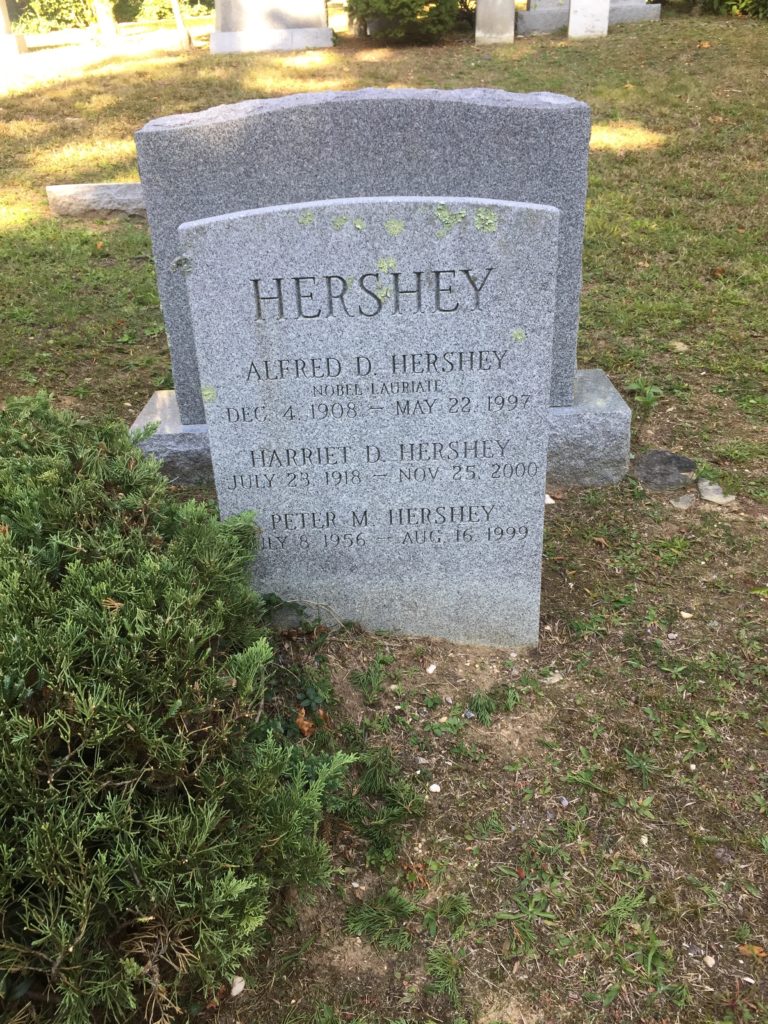Erik Visits an American Grave, Part 978
This is the grave of Alfred Hershey.

Born in 1908 in Owosso, Michigan, Hershey grew up in Michigan and attended Michigan State University. He graduated from Sparty in 1930 with a degree in chemistry. He stuck around for his PhD in bacteriology and got that in 1934. His initial research was on brucellosis, spread from animals to people in unpasteurized dairy products.
Hershey got a job at the Washington University School of Medicine in St. Louis. Working with his department chair, Jacques Bronfenbrenner, he became an expert on bacteria and antibodies. I’m not going to lie, I have no ability to get into the weeds of things such as medicine. Like most rational people, I trust my doctor on these issues instead of what I see on Fox News or a pharmaceutical commercial. So I am just going to quote the American Association of Immunologists webpage on Hershey.
During the late 1930s, Hershey and Bronfenbrenner studied the growth of bacterial cultures, but his own experiments in the early 1940s focused on the phage-antiphage immunologic reaction and other factors that influenced phage infectivity. Looking back over them 60 years later, Stahl wrote that these studies “appear original, thoughtful, and quantitative, especially those on the use of phage inactivation to permit the study of the antigen-antibody reaction at ‘infinite’ dilution of antigen.”
In late January 1943, Delbrück invited Hershey to Nashville to discuss his phage experiments with him and his close friend Luria. Together, the three formed the nucleus of the “phage group,” an informal network of the growing number of scientists devoted to studying the bacteriophage. In 1946, Hershey and Delbrück, working independently, found that different strains of bacteriophage can exchange genetic material when both have infected the same bacterial cell, creating a bacteriophage that is a hybrid of the two, a process Hershey referred to as genetic recombination. By the mid-1940s, Hershey’s research with bacteriophage began to shift away from immunology to genetics, biochemistry, and molecular biology.
In 1950, Hershey became a staff member in the Department of Genetics of the Carnegie Institution of Washington at the Cold Spring Harbor Laboratory on Long Island. It was here that he and Chase conducted the blender experiment. In 1962, Hershey was named head of the Genetics Research Unit at Cold Spring Harbor, a position he held until his retirement in 1972.
Uh. OK. Anyway, Hershey won the Nobel Prize for Medicine in 1969, along with Max Delbrück and Salvador Luria “for their discoveries concerning the replication mechanism and the genetic structure of viruses,” according to the Nobel announcement.
Well, I could probably make this longer, but I am way, way over my head here.
Alfred Hershey is buried in Memorial Cemetery of St. John’s Church, Laurel Hollow, New York.
If you would like this series to visit other winners of the Nobel Prize in Medicine, and why wouldn’t you given the high quality of this post, you can donate to cover the required expenses here. Marshall Nirenberg, who won in 1968 for his work on the genetic code, is in Valhalla, New York, and George Wald, who won in 1967 for his work on the study of the eye, is in Woods Hole, Massachusetts. Previous posts in this series are archived here.


